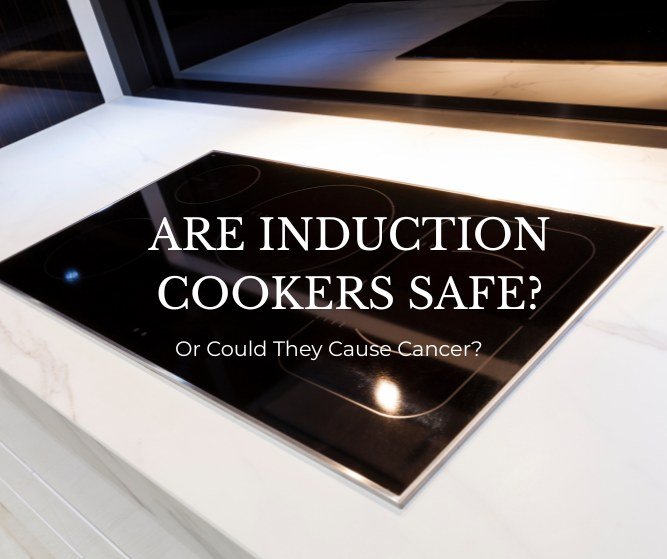
Induction cooktops are sleek, fast, and feel like a smart upgrade, but a lot of people wonder the same thing once they dig a little deeper — are they actually safe, and more importantly, could they cause cancer?
The short answer is: we don’t have solid proof that they do, but we also can’t say for certain that they don’t. What we do know is that induction cookers emit electromagnetic fields (EMFs), and if you’re standing close — which you often are when cooking — the level of exposure can go above what’s considered safe.
That doesn’t automatically mean danger, but it’s something worth thinking about, especially if you’re already exposed to other environmental stressors or trying to make healthier choices at home.
Let’s take a closer look at how these cooktops work, what kind of EMFs they give off, and what the science actually says about the risks.
Let’s Be Real: Cancer Is Complicated
There’s rarely ever one single cause behind cancer. It’s usually the result of many different factors building up over time — things like diet, air quality, genetics, stress, chemical exposure, and lifestyle habits. So when people ask if something like an induction cooktop can cause cancer, it’s not a question with a simple yes or no.
What we can say is that induction cooking involves exposure to low-frequency electromagnetic fields. On their own, these aren’t classified as directly harmful in the way that, say, X-rays or gamma rays are — but that doesn’t mean they’re completely harmless either. When combined with other risk factors in your life, even low-level exposures can potentially contribute to a bigger picture that affects your health over time.
So while one appliance likely isn’t the deciding factor, it makes sense to be mindful — especially when the exposure happens right in front of you, for extended periods, several times a week. It’s not about panic or paranoia — it’s about being aware and making thoughtful choices where you can.
How Induction Cookers Actually Work (And Why That Matters)
Induction cooktops don’t use flames or heated coils. Instead, they create a magnetic field that heats your pan directly. Under the glass surface, there’s a coil that generates an electromagnetic field when switched on. If your cookware is made from magnetic material — like cast iron or some stainless steel — the field causes it to heat up.
The pan gets hot, not the stove. That’s why induction is fast, efficient, and safer in some ways — there’s less wasted heat, and the surface stays cooler. But this only works because of that electromagnetic field, and that’s where health concerns come in.
Using one means standing close to a strong EMF source, often for long periods while cooking. That’s why it’s important to understand what kind of exposure we’re talking about — and how it compares to other devices around your home.
What Are EMFs and Why Do They Matter?
EMFs, or electromagnetic fields, are invisible forms of energy that come from all sorts of things — power lines, mobile phones, Wi-Fi routers, and yes, induction stoves. But not all EMFs are the same, and that’s where it gets important.
There are two main types:
- Ionizing radiation – high energy, can damage DNA, and is linked to cancer (think X-rays, gamma rays).
- Non-ionizing radiation – lower energy, not known to cause direct cell damage (this includes induction cooktops, phones, and Wi-Fi).
Induction stoves fall into the non-ionizing category. That’s why they’re generally labeled as safe. But “non-ionizing” doesn’t automatically mean harmless.
When you’re standing right next to a source — like while cooking — you’re getting a stronger dose than you would from a Wi-Fi router across the room. And with regular, long-term exposure, that could potentially have subtle effects.
That’s what raises concern. Not because induction cookers have been proven harmful, but because we don’t fully understand the impact of being exposed up close, often, over time.

How EMFs from Induction Cookers Compare to Other Devices
To understand whether induction cooktops are a real concern, it helps to look at how their EMF levels stack up against other devices we use every day.
The type of radiation is the same — non-ionizing — but the frequency and your distance from the source make a big difference.
Here’s a quick comparison:
| Device | Frequency Range | Typical Distance from User | EMF Exposure Level |
|---|---|---|---|
| Induction Cooktop | 20–100 kHz | A few centimeters while cooking | High at close range |
| Mobile Phone | 900–1800 MHz | Held against head or in hand | Medium–high, short bursts |
| Wi-Fi Router | 2.4 / 5 GHz | Across the room | Low |
| Microwave Oven | 2.45 GHz | Typically 30+ cm away, shielded | Very low (unless damaged) |
Induction cooktops operate at much lower frequencies than phones or Wi-Fi, but the intensity of the magnetic field is stronger when you’re very close — and that’s exactly how most people use them. Unlike a phone or router, which you can put down or keep at a distance, you’re usually right over the cooktop, cooking and stirring.
The takeaway? While the frequency is lower, the exposure is more concentrated because of how close you are during use. That’s why safety guidelines recommend keeping a distance — but in practice, that’s not always possible when you’re in the middle of making dinner.
Can EMF Exposure from Induction Cooking Be Harmful?
There isn’t any solid evidence showing that EMFs from induction cookers cause harm, but the research is limited, and most of it doesn’t reflect how people actually use these stoves. Studies often focus on controlled lab conditions, not the reality of leaning over a hot pan for twenty minutes while stirring.
According to the International Commission on Non-Ionizing Radiation Protection (ICNIRP), public exposure to EMFs at the frequencies used in induction cooking should stay below 6.25 microteslas. Most cooktops do stay under that level — as long as you’re standing at least 30 cm away. But in a real kitchen, that’s not always practical.
One study published in Bioelectromagnetics found that EMF exposure from induction hobs could exceed recommended limits if a person was standing closer than 25 cm, especially with smaller or misaligned cookware.
Another report from Powerwatch, a UK-based EMF monitoring group, came to similar conclusions: the risk isn’t extreme, but it increases the closer you are and the longer you’re exposed.
So while current evidence doesn’t confirm a health risk, it also doesn’t rule it out — and that’s why this remains a grey area. It’s not about panic, but about understanding the conditions where exposure might be higher than expected.
Does Induction Cooking Cause Cancer?
No, there’s no conclusive evidence that induction cookers cause cancer. But that doesn’t mean the answer is a firm no — it’s more accurate to say the science is incomplete.
The World Health Organization (WHO) and the International Agency for Research on Cancer (IARC) have both looked into electromagnetic fields and their potential health effects.
The IARC classifies low-frequency EMFs — the kind induction cookers emit — as “possibly carcinogenic to humans” (Group 2B). That puts them in the same category as things like lead and engine exhaust. It doesn’t mean they cause cancer, just that there’s limited evidence, and more research is needed.
It’s worth noting that this classification was largely based on studies involving power lines and long-term exposure, especially in children. Induction stoves use similar frequencies, but the data specifically on cooktops is very limited.
No study has directly linked induction cooking to cancer, but we also haven’t seen enough long-term research in real-world conditions to fully rule it out.
That’s really the point — it’s not about claiming danger, it’s about acknowledging uncertainty. And when there’s uncertainty, especially around something you’re exposed to often and up close, it makes sense to be cautious.
What I’d Personally Recommend
When the science is vague and the long-term research isn’t there, I tend to err on the side of caution. That’s especially true when there’s a simple alternative that doesn’t come with a question mark.
In this case, I wouldn’t recommend buying an induction cooktop — not because it’s proven to be dangerous, but because we just don’t know enough.
If you’re standing close to it day after day, and your exposure regularly exceeds what’s considered safe, it’s fair to wonder how that adds up over time.
Combine that with a not-so-great diet, lack of exercise, exposure to environmental toxins, and general everyday stress, and it becomes one more thing your body has to deal with. Not necessarily a cause, but part of a bigger picture.
A standard electric stove is a safer bet. It does the job, it’s reliable, and you’re not dealing with EMFs. It’s one less unknown to worry about — especially if you have small kids around, or if you’re already trying to live a lower-toxin lifestyle.
No appliance is going to make or break your health, but small, thoughtful choices do add up. This is one of them.
At the end of the day, it’s not about fear — it’s about making informed choices. If there’s even a small chance that long-term, close-up exposure to EMFs could be a problem, and there’s a safer alternative available, why take the risk? Keep it simple, stay aware, and choose what helps you feel good in your own home.















Leave a Reply